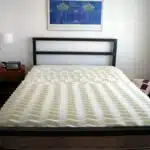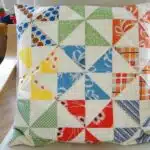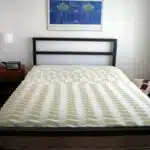As a bed linen expert, I have come across countless individuals who struggle with making their beds. While it may seem like a simple task, creating a perfectly made bed requires attention to detail and the right technique. A well-made bed not only enhances the overall appearance of your bedroom but also provides a comfortable and inviting space for you and your guests to rest.
In this article, we will explore the art of bed-making and provide tips on how to make your bed like a pro. From choosing the right bedding materials to mastering the technique of tucking in sheets, we will cover everything you need to know to achieve a perfectly made bed. So whether you are hosting guests or looking to create a more luxurious sleeping experience for yourself, read on for our expert advice on how to make your bed like a pro.
Choosing The Right Bedding Materials
What sets a professionally made bed apart from one that is not? One important factor is the use of high-quality bedding materials. Different types of bedding materials have their own pros and cons. To make the right choice, it is important to consider factors such as comfort, durability, and ease of maintenance.
One popular material for bedding is cotton. Cotton sheets are soft, breathable, and durable. They also come in a variety of thread counts which determine their quality and price point. However, cotton does wrinkle easily and may require more ironing than other materials.
Another option is linen bedding. Linen is a highly durable material that becomes softer with each wash. It also has natural cooling properties which make it an ideal choice for warmer environments. However, linen tends to be more expensive than other materials and can be difficult to maintain due to its tendency to wrinkle easily.
Lastly, there are synthetic blends such as polyester or microfiber that offer both affordability and easy maintenance. They are resistant to wrinkles and stains but may not provide the same level of breathability as natural fibers like cotton or linen.
Choosing the right type of bedding material can make a significant difference in how comfortable your bed feels. Consider your personal preferences along with factors such as durability, ease of maintenance, and climate when making your decision. Once you have chosen your preferred bedding material, you can move on to preparing your mattress for optimal comfort and support.
Preparing Your Mattress
- Before preparing a mattress, it is important to strip the mattress of all existing sheets and bedding.
- Vacuuming the mattress surface can help to remove dirt, dust, and other particles that may have accumulated.
- Cleaning the mattress surface with a mild detergent can help to remove any stains, as well as freshen the mattress.
- Finally, adding fresh bedding and sheets can help to ensure that the mattress is properly protected and comfortable.
Stripping
Preparing your mattress for a good night’s sleep involves more than just fluffing pillows and smoothing out sheets. One of the essential steps in creating a comfortable sleeping environment is stripping the bed and washing linens. As a professional bed maker or bed linen expert, I cannot stress enough the importance of this step in maintaining the cleanliness of your bedding.
Before washing linens, removing stains on your mattress is crucial to prevent unwanted odors and bacteria growth. Use a damp cloth with mild detergent to spot clean any visible stains on your mattress surface. Be sure not to over-wet the area as it may cause mold or mildew growth which can be harmful to your health.
When it’s time to wash linens, make sure to follow care instructions provided by the manufacturer. Opt for warm water instead of hot as it can damage fibers and cause shrinkage. Also, avoid using bleach or fabric softeners as they can weaken fabrics over time. By following these simple yet effective tips, you’ll be able to achieve a professional-looking bed that will provide a comfortable and refreshing sleep every night.
Cleaning
Maintaining a clean sleeping environment is crucial to achieving a good night’s sleep. Cleaning your mattress is one of the most important steps in preparing it for use. Over time, mattresses can accumulate sweat, dirt, and other debris that can cause unwanted odors and bacteria growth. As a professional bed maker or bed linen expert, I highly recommend regular cleaning to ensure the longevity of your mattress.
When it comes to cleaning your mattress, there are some dos and don’ts you should keep in mind. Do use a vacuum cleaner with a HEPA filter to remove dust mites and allergens from the surface of your mattress. Don’t use harsh chemicals or excessive amounts of water when spot-cleaning stains as this may damage the mattress’s material or cause mold growth. Additionally, avoid using steam cleaners as they can also damage some materials.
Regularly washing your bedding is another essential aspect of maintaining a clean sleeping environment. To keep your sheets and other linens fresh and comfortable, follow care instructions provided by the manufacturer. Some tips include using a mild detergent in warm water instead of hot, avoiding bleach or fabric softeners that can weaken fabrics over time, and drying linens thoroughly before storing them away. By incorporating these tips and tricks into your routine, you’ll be able to enjoy a comfortable and refreshing sleep every night.
Layering Your Bedding
The way you layer your bedding can make a significant difference in the overall look and feel of your bed. Different layering styles can also serve different purposes, such as providing warmth or creating a more polished appearance. For instance, layering with a quilt, duvet cover, and top sheet can give your bed a cozy and inviting feel while adding layers of decorative pillows and throws can create a more stylish look.
When it comes to layering for different seasons, it’s important to consider the weight and fabric of each layer. For warmer months, lighter fabrics like linen or cotton are ideal while heavier fabrics like flannel or fleece are better suited for colder months. Additionally, incorporating seasonal colors or patterns can help set the mood for your bedroom decor.
To achieve a well-layered bed, start with your fitted sheet as the base. Add a flat sheet on top followed by any additional layers such as blankets or comforters. When selecting decorative pillows and throws, choose pieces that complement the color scheme of your bedding while adding texture and visual interest.
In summary, mastering the art of layering your bedding is an excellent way to elevate your bedroom decor. Experiment with different layering styles and fabrics to find what works best for you and don’t forget to switch things up according to the season. Next up we’ll discuss how to properly fluff your pillows for a perfectly styled bed.
Fluffing Your Pillows
As the saying goes, “Fluffing your pillows is like putting icing on a cake.” It may seem like a small detail, but it can make all the difference in creating a professional-looking and comfortable bed. Fluffing techniques vary depending on the type of pillow you have, but they all aim to redistribute the filling evenly and create that inviting plumpness.
For down or feather pillows, start by giving them a good shake to fluff up the filling. Then, grab opposite corners of the pillow and push them towards each other to redistribute the feathers or down. Repeat this process on all four sides until you achieve your desired fluffiness. For synthetic pillows, use your hands to fluff up the filling by pulling and separating it gently.
When arranging your pillows, consider both functionality and aesthetics. Start with two sleeping pillows placed side by side against the headboard or wall. Place any decorative shams or covers over these pillows. Then add any additional sleeping pillows you may have behind these shams for extra support while sitting up in bed. Finally, place any decorative pillows in front of everything else to add a pop of color or texture.
Next up: adding decorative pillows that complement your bedding and tie everything together seamlessly.
Adding Decorative Pillows
Adding decorative pillows is an excellent way to elevate the overall look of your bed and make it appear more luxurious. When choosing decorative pillows, be sure to mix patterns to add depth and interest to your bedding. Pairing different patterns can be tricky, so consider using a common color scheme to tie them together.
Color coordination is also essential when selecting decorative pillows. You want to choose colors that complement each other rather than clash. If you’re unsure about which colors work well together, consider using a color wheel or consult with a professional bed linen expert for advice.
By adding decorative pillows that are well-coordinated with your bedding, you can create a cohesive and welcoming look in your bedroom. Mixing patterns and coordinating colors will give your bed an added touch of sophistication that will impress anyone who enters the room. In the next section, we will discuss how to properly tuck in your sheets for a crisp finish.
Tucking In Your Sheets
Mastering tucking: tips and tricks for a snug fit is an essential skill to learn when making your bed like a pro. Tucking in your sheets not only makes your bed look neater, but it also helps keep your bedding secure throughout the night for a better night’s sleep. However, having perfectly tucked-in sheets can be tricky to achieve, especially if you have deep or irregularly shaped mattresses.
To start, make sure to pull the sheet taut across the mattress before tucking it in. This will prevent any excess fabric from bunching up underneath you while you sleep. Then, begin tucking in the sides of the sheet at one corner of the bed, making sure to create hospital corners for a crisp finish. Repeat this process on the opposite side of the bed and then move on to tucking in the foot of the sheet. Remember to smooth out any wrinkles or creases as you go along.
One helpful trick is to use sheet suspenders or clips to keep your sheets securely tucked in throughout the night. These gadgets attach directly onto the corners of your sheets and anchor them firmly into place. With these tips and tricks under your belt, you’ll be able to master tucking in your sheets for a snug fit every time. Next up, we’ll explore how to fold your flat sheet for a perfectly polished finish.
Folding Your Flat Sheet
- First and foremost, it is important to determine the size of the flat sheet in comparison to the bed before attempting to fold it.
- The sheet should be laid flat on the bed, with the top of the sheet facing away from the bed.
- The sheet should be pulled and adjusted so that it is taut and evenly spread over the mattress.
- Once the sheet is placed, it should be carefully folded on either side and tucked in at the foot of the bed.
Determine Sheet Size
Determining the sheet size is a crucial aspect of making your bed like a pro. Measuring tips are necessary to ensure you find the perfect fit for your flat sheet. The standard size of a flat sheet is 81 inches by 96 inches, but depending on your mattress’s depth and size, you may need to go up or down in measurements.
When measuring your mattress, be sure to measure its length, width, and depth. For width and length, add an extra six inches on each side to allow for tucking under the mattress. For depth, measure from the top of the mattress to the bottom edge. This will give you an accurate measurement that will help you choose the right size of flat sheet.
Once you have determined the correct size of flat sheet needed for your bed, finding the perfect fit becomes much easier. No one likes ill-fitting sheets that slip off or bunch up during sleep. A well-fitted flat sheet should lay smoothly across the bed without any wrinkles or sagging corners. With these measuring tips in mind, finding the perfect fit for your flat sheet will ensure a comfortable night’s rest and make you look like a pro at making your bed.
Place On Bed
After determining the correct size of flat sheet for your bed, the next step is to place it on your bed properly. As a professional bed maker or bed linen expert, it is important to ensure that the flat sheet is centered and aligned correctly. To do this, start by laying the sheet over the mattress with the top edge of the sheet at the head of the bed. Then, ensure that both sides of the sheet hang evenly over each side of the mattress.
Once you have centered your flat sheet, it’s time to tuck in its edges under your mattress. Begin by tucking in one corner of the fitted sheet tightly under your mattress and move on to the other corner diagonally opposite from where you started. Repeat this process until all four corners are securely tucked in. This will prevent any shifting or bunching up of your flat sheet while you sleep.
Finally, add centering pillows and throw pillows for a polished look. Centering pillows help to create balance and symmetry in your bedding while throw pillows add an element of comfort and style. When arranging these pillows, use odd numbers like three or five to create visual interest. Remember that making a bed is not just about functionality but also aesthetics. With these tips in mind, you’ll be able to make a perfectly made bed that looks as good as it feels!
Creating Hospital Corners
The key to making a bed look professional lies in the details, and creating hospital corners is one of those essential details. Hospital corners are a fold technique that creates tight corners on your bed linens, giving your bed a more polished and refined appearance. This technique is commonly used in hotels, hospitals, and military barracks to create a neat and tidy bed.
To create hospital corners, start by tucking the end of the sheet under the mattress at the foot of the bed. Then, pull the sheet up towards the headboard until it’s taut and smooth. Next, take one side of the sheet at the foot of the bed and lift it up diagonally to form a triangle. Fold this triangle down onto the mattress, creating a straight edge along the side of your bed.
Now comes the tricky part – tuck in both sides of this triangular flap under your mattress tightly. Repeat this process on both sides of your bed before adding your duvet or comforter on top. With practice, you’ll master this technique for creating tight corners every time you make your bed. The next step will be placing your duvet or comforter effortlessly to complete your perfectly made bed.
Placing Your Duvet Or Comforter
Did you know that the average person spends about 26 years of their life sleeping? That’s a lot of time spent in bed, which means it’s crucial to make sure your bedding is comfortable and visually pleasing. One way to achieve this is by properly placing your duvet or comforter.
First, start by selecting a duvet cover that complements the color scheme of your room. This will help create a cohesive and inviting atmosphere. Once you have chosen your cover, lay it flat on top of your bed with the opening at the foot of the bed. Then, place your duvet or comforter inside the cover and fasten all buttons or ties to secure it in place.
Properly placing your duvet or comforter not only enhances the overall appearance of your bed but also extends its lifespan. By following these simple steps, you can create a cozy and inviting space for yourself or guests to enjoy a restful night’s sleep. In the next section, we will discuss how to fold your duvet or comforter for maximum organization and storage efficiency.
Folding Your Duvet Or Comforter
After making your bed, it is time to fold your duvet or comforter. If you have a duvet cover, removing it for washing and then putting it back on can be quite tedious. Luckily, there are alternatives. You can opt for a top sheet and coverlet combination instead of a duvet cover, or choose a quilt that can easily be laundered.
To fold your duvet or comforter, first shake it out to remove any lumps or bumps. Then, fold it in half lengthwise and smooth out any wrinkles. Fold it in half again and continue until the size is manageable for storage. Be sure to store your duvets in a dry place away from sunlight as humidity and light can damage the filling over time.
When storing your duvets, avoid vacuum-sealed bags as they compress the filling and cause clumping. Instead, use breathable cotton bags or simply store them on an open shelf or in a closet with good air circulation. Taking proper care of your bedding will help ensure its longevity and keep you sleeping soundly for years to come.
As you complete folding your duvet or comforter, it’s time to think about adding a bedspread or blanket. This step adds an extra layer of warmth and style to your bed while also protecting your primary bedding from stains or spills. In the next section, we will discuss how to choose the right bedspread or blanket for your needs and how to properly layer them on top of your bedding for maximum comfort and aesthetic appeal.
Adding A Bedspread Or Blanket
After folding your duvet or comforter, it’s time to add a bedspread or blanket to complete the look of your bed. Choosing the right color for your bedspread can make a significant difference in the overall appearance of your bedroom. If you have a neutral-colored room, you may opt for a bold and bright bedspread to add some pop of color. Matching patterns and textures are also crucial when selecting a bedspread. You can choose a patterned bedspread that complements the texture of your pillows or curtains.
When it comes to matching patterns and textures, there are no hard and fast rules. However, it’s essential to keep in mind that too many patterns can be overwhelming and clash with each other. Therefore, if you already have patterned curtains or throw pillows in your room, you may want to choose a solid-colored bedspread rather than adding more patterns. Similarly, if your bedding is already textured, such as with ruffles or pleats, you may want to choose a smooth bedspread instead.
Once you’ve selected the perfect bedspread or blanket, it’s time to place your throw pillows on top. Throw pillows can add an extra layer of comfort and style to your bedding ensemble. When placing them on your bed, arrange them in odd numbers (such as three or five) rather than even numbers for symmetry. You can mix and match different sizes and colors of pillows for added interest. By following these simple tips for adding a bedspread or blanket and placing throw pillows on top, you’ll be able to create an inviting sleeping space that looks like it was made by a pro!
Placing Your Throw Pillows
After successfully arranging your main pillows, it’s time to add some throw pillows to complete the look. A common mistake is to use too many or too few throw pillows, leading to an unbalanced appearance. To avoid this, consider color coordination when choosing your pillow covers and placing them on the bed.
Choose throw pillow covers that complement the color scheme of your bedding and room decor. You can experiment with different textures and patterns while keeping the colors in harmony with each other. For instance, if your bedding has a floral pattern, choose solid-colored pillow covers with a similar color palette or a subtle print that complements the pattern.
When it comes to arranging your throw pillows, there are no strict rules. However, a popular method is placing two larger square pillows at the back and two smaller rectangular ones in front. This creates depth and adds visual interest to your bed. Alternatively, you can stack two or three pillows of different sizes on top of each other for a more casual look. Remember to fluff up your pillows regularly for maximum comfort and style.
By now, you have learned how to arrange your main pillows and coordinate your throw pillows for a cohesive look. The next step is accentuating with throw blankets to add warmth and texture to your bed.
Accentuating With Throw Blankets
When selecting throw blankets for accentuating a bed, it is important to consider the size, pattern, and color of the fabric. Properly arranging the throw blankets is essential to creating a balanced and aesthetically pleasing look. Blanket placement can be determined by the size of the bed and the design of the blankets themselves. Throws can also be layered to create a textured, inviting atmosphere.
Choosing Blankets
To truly elevate the appearance of your bed, one must not overlook the importance of choosing the right blankets. The materials and thickness of blankets can make all the difference in creating a sophisticated and inviting atmosphere in your bedroom.
When selecting blanket materials, consider both aesthetic and practical factors. Luxurious options such as cashmere or silk add a touch of elegance to any bedding ensemble. However, for everyday use, it may be more practical to opt for easy-care materials such as cotton or microfiber. In addition, consider the weight and warmth of the blanket – a heavier option may be perfect for chilly winter nights while a lighter option is ideal for warmer seasons.
Blanket thickness is another important factor to consider when accentuating with throw blankets. A thicker blanket can add texture and dimension to your bedding while also providing extra warmth. Alternatively, a thinner blanket can create a sleeker look that is perfect for layering with other bedding elements. When choosing thickness, keep in mind the overall style you are trying to achieve and how it will complement other elements on your bed.
Remember that choosing the right blankets is an essential step in making your bed like a pro. By taking into account both material and thickness, you can create an inviting space that exudes sophistication and comfort.
Arranging Throw Blankets
When it comes to accentuating with throw blankets, the right arrangement can make all the difference in creating a polished and inviting look. Mixing textures is a great way to add interest and depth to your bedding ensemble. Consider pairing a chunky knit throw with a smooth velvet one or layering a faux fur blanket over a woven cotton one. This not only creates visual interest but also provides varying levels of warmth and comfort.
Choosing colors is also an important aspect of arranging throw blankets. While it may be tempting to stick to neutral tones, adding a pop of color can bring life to your bedding and tie together different elements in the room. However, be mindful of clashing colors or patterns that may overwhelm the space. One approach is to choose one dominant color and incorporate throws in varying shades and textures within that color family.
When arranging throw blankets, consider draping them over the foot or side of the bed for a relaxed yet chic look. Alternatively, folding them neatly at the end of the bed can create a more structured appearance. Experiment with different arrangements until you find what works best for your personal style and bedroom decor. With these tips in mind, you can elevate your bedding game and create a cozy haven for yourself or your guests.
Finishing Touches With Bed Skirts
Adding Bed Skirts is one of the most critical finishing touches when making a bed like a pro. It not only adds an extra layer of protection to your mattress, but it also serves as a decorative element that can elevate the overall appearance of your bedding. Whether you choose to go for a tailored or ruffled bed skirt, ensure that it complements the aesthetics of your room.
Choosing Bed Skirt Colors might seem like a daunting task, but it doesn’t have to be. When selecting a bed skirt color, consider the color scheme of your room and make sure it blends well with other elements in the space. If you’re unsure about what color to choose, opt for neutrals like white, beige or gray – these colors are timeless and work well with any decor style.
Incorporating Bed Skirts into your bedding routine is an easy way to add style and sophistication to your bedroom space. Take some time to experiment with different bed skirt styles and colors until you find what works best for you. Adding this simple touch will not only make your bed look more luxurious but will also create a calming oasis that you’ll love coming home to every night.
Transition: Now that we’ve covered how to add those finishing touches let’s dive into how maintaining a clean and tidy bed can help you sleep better at night.
Maintaining A Clean And Tidy Bed
A well-made bed not only adds to the visual appeal of a room, but it also promotes better sleep hygiene. A tidy sleeping space can help reduce stress and improve overall wellbeing. To maintain a clean and tidy bed, there are a few tips that one can follow.
Firstly, it is important to make the bed every morning. This simple task sets the tone for the day and ensures that the bed is ready for use at night. It only takes a few minutes to straighten out the sheets and fluff up the pillows, but it makes all the difference in creating a welcoming and inviting sleeping space.
Secondly, regularly washing bedding is crucial for maintaining a clean bed. Sheets should be washed once a week, while duvet covers and pillowcases should be washed every two weeks. This helps to remove any dirt or bacteria that may have accumulated over time and keeps your sleeping space fresh.
Lastly, decluttering the bedroom can also contribute to maintaining a clean and tidy sleeping space. Keeping surfaces clear of unnecessary items such as books or clothing helps create an organized environment that promotes relaxation.
Benefits of a well made bed:
- Provides visual appeal to your room
- Promotes better sleep hygiene
- Sets tone for a productive day
Tips for maintaining a tidy sleeping space:
- Make your bed every morning
- Regularly wash bedding
- Declutter your bedroom
- Create an organized environment
A clean and tidy bed goes beyond aesthetics; it has tangible benefits on our mental health as well. By following these simple tips, you can create an inviting sleeping space that promotes relaxation and reduces stress levels. Remember to make your bed every morning, regularly wash bedding, declutter your bedroom, and create an organized environment for optimal results.
Conclusion
In conclusion, making your bed like a pro requires attention to detail and careful consideration of bedding materials. By choosing quality sheets and comforters that match your personal style and preferences, you can create a cozy and inviting sleeping space that feels just right. Preparing your mattress with proper support and protection is also key to ensuring a comfortable night’s sleep.
Layering your bedding with a fitted sheet, flat sheet, and comforter or duvet adds depth and dimension to your bed. Fluffing your pillows and adding decorative accents such as throw pillows or blankets can elevate the overall aesthetic of your bedroom. And don’t forget about finishing touches like bed skirts to complete the look.
As a bed linen expert, I recommend taking the time to maintain a clean and tidy bed by regularly washing your sheets, pillowcases, and comforter covers. Investing in high-quality bedding materials will not only enhance the appearance of your bed but also contribute to better sleep hygiene. So go ahead, make your bed like a pro, and enjoy a peaceful night’s rest in style. As the saying goes, “a well-made bed is a work of art.”
Image Credits
- “Making a Bed” by Beegee49 (Thanks for 12m views,account locked (featured)




![How To Keep Sheets On A Bed: 10 Strategies 4 Bed sheets [Explored 2013-04-27]](https://green-life.blog/wp-content/uploads/2023/04/pH7FwL8jspjq-150x150.jpg.webp)
























